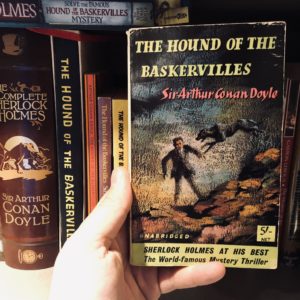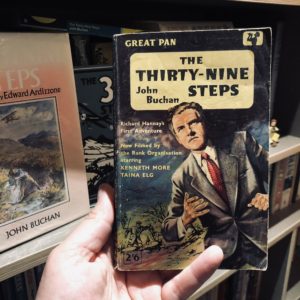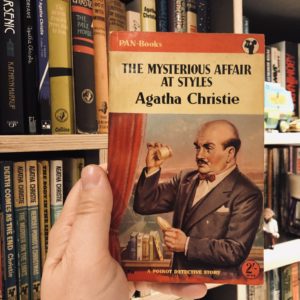Decades: Compiling the Ultimate Library with Danny Marshall
I never fail to be surprised by the selections made by my Decades guests. Until I recieve the email with their choices they give nothing away about the books which they may choose. However, when I first asked Danny Marshall if he would like to take on my Decades Challenge I had no idea that he would introduce three of fiction’s most famous characters to the Library.
For new readers a quick Decades recap. I am inviting guests to nominate books which they believe should be included in the Ultimate Library. Or to put it another way: if I had to fill a new library with the best books out there, but I was starting with zero books on the shelves, which books should be added? I cannot make these tough choices so my guests are invited to add their favourite books.
There are just two rules governing their choices:
1 – Pick ANY Five Books
2 – You Can Only Choose One Book Per Decade Over Five Consecutive Decades
Now I hand you over to Danny to introduce himself and share his choices
DECADES
I’m D.L. Marshall – better known as Danny (but unfortunately that’s not a very authorly name) – and my debut novel Anthrax Island was published recently. Described by some as Alistair MacLean meets Agatha Christie, it’s a claustrophobic locked-room mystery (in the literal sense) meets adventure thriller.
 Anthrax Island is a real place off remote north-western Scotland, having received its sinister moniker in the tabloids when top-secret files were declassified. Its real name is Gruinard, and it was used by the Ministry Of Defence during the second world war to test biological weapons, leaving it a lethally contaminated no-go zone for decades. The government finally (and begrudgingly) cleaned it up in the Eighties, declaring it anthrax-free in the Nineties, though given the extreme hardiness of anthrax spores some people remain unconvinced!
Anthrax Island is a real place off remote north-western Scotland, having received its sinister moniker in the tabloids when top-secret files were declassified. Its real name is Gruinard, and it was used by the Ministry Of Defence during the second world war to test biological weapons, leaving it a lethally contaminated no-go zone for decades. The government finally (and begrudgingly) cleaned it up in the Eighties, declaring it anthrax-free in the Nineties, though given the extreme hardiness of anthrax spores some people remain unconvinced!
The premise of the novel is that a team of scientists have returned to the island due to a resurgence of bacteria. Their only technician is dead, a victim of anthrax poisoning, and their base has suffered a malfunction. Enter our hero Tyler, a replacement technician flown out to fix the base. He quickly discovers sabotage, and works out his predecessor was murdered. Soon after, another team member is murdered inside a sealed room in the base with Tyler right outside the door – but when he enters seconds later the killer has vanished. Now with a storm closing in, the radios destroyed, and the bodies piling up, it seems they’re trapped on the island with a far more dangerous killer than anthrax…
I’m honoured to take part in decades, having read previous entries with great interest! There have already been some absolute belters already added to the library, so I hope I can do it justice. Though there were some difficult choices – I could talk for hours about the ones I left out – I had great fun picking my entries. I could have chosen any number of crime and espionage thrillers from the mid-to-late Twentieth century, but I decided to take my fifty years a little earlier to encompass some of my very favourite and most re-read novels of all time. They’re also all novels that have influenced my writing a great deal, and all feature in Anthrax island in some way.
1890s
Bram Stoker’s Dracula (1897)
 Does any other single word in the world of fiction evoke such an emotional response? How many other book titles are so well known? I think you could make a case for it being the most influential book of all time; fiction, films, pop culture, it’s a staggering legacy. Stoker didn’t invent vampires, horror, or gothic fiction, but he did weave them all into a fantastically modern narrative that popularised all the right elements. It’s a story of an ancient evil assaulting the modern world that we’ve loved ever since, from Lovecraft to Carpenter. I only found out fairly recently that it wasn’t a huge success in Stoker’s lifetime – it did okay and was well received (Arthur Conan Doyle wrote a glowing letter to Stoker), but he died poor. It wasn’t until the landmark copycat film Nosferatu in the Twenties – and the subsequent legal dispute – that the book took off, and since the first Hollywood Dracula film a few years later the book has never been out of print.
Does any other single word in the world of fiction evoke such an emotional response? How many other book titles are so well known? I think you could make a case for it being the most influential book of all time; fiction, films, pop culture, it’s a staggering legacy. Stoker didn’t invent vampires, horror, or gothic fiction, but he did weave them all into a fantastically modern narrative that popularised all the right elements. It’s a story of an ancient evil assaulting the modern world that we’ve loved ever since, from Lovecraft to Carpenter. I only found out fairly recently that it wasn’t a huge success in Stoker’s lifetime – it did okay and was well received (Arthur Conan Doyle wrote a glowing letter to Stoker), but he died poor. It wasn’t until the landmark copycat film Nosferatu in the Twenties – and the subsequent legal dispute – that the book took off, and since the first Hollywood Dracula film a few years later the book has never been out of print.
I’ve just looked at my shelves and I currently own seven copies of Bram Stoker’s Dracula, the latest being a graphic novel my partner bought for me to read with my son. The particular reason I love it may be down to my final year of primary school, when we had a week’s residential in Whitby. The teachers wouldn’t take a bunch of ten year olds in ‘The Dracula Experience’ but we spent our money in the gift shop, then sat up at night in our shared room, telling ghost stories while looking out of the window at the ruins of the abbey across the harbour. As a Yorkshireman I love that Whitby section, and the newspaper reports of the wild dog roaming the North Yorkshire moors, but actually my favourite is the opening – Harker’s dangerous voyage through the Carpathian Mountains to meet his mysterious host. The wolves, the warnings from locals, the superstitious coachman, all now absolute staples of horror films. The opening of Anthrax Island was written as a homage. Bonus points if you can spot which character from Anthrax Island is named for something in Dracula…
1900s
Arthur Conan Doyle’s The Hound of the Baskervilles (1901-1902)
 Another of the most famous books ever written! Spoilers (although it’s a century old, where have you been?) When first serialised it brought Holmes back from the dead, since he was killed at the Reichenbach Falls in 1893’s ‘The Final Problem’. Conan Doyle was adamant Holmes wouldn’t return, so when public opinion forced him to write another story he stubbornly set it before his death. However, the success of Baskervilles was such that he finally relented and truly resurrected Holmes.
Another of the most famous books ever written! Spoilers (although it’s a century old, where have you been?) When first serialised it brought Holmes back from the dead, since he was killed at the Reichenbach Falls in 1893’s ‘The Final Problem’. Conan Doyle was adamant Holmes wouldn’t return, so when public opinion forced him to write another story he stubbornly set it before his death. However, the success of Baskervilles was such that he finally relented and truly resurrected Holmes.
I have seven copies of Dracula but I have ten copies of The Hound of the Baskervilles! I’ve read it at least once a year since I was a kid. Apart from being my favourite book of all time, it is – in the opinion of Sherlock scholars – the best Holmes novel. I love stories that tread the line between crime and horror, and for me this is the epitome. Ghostly lights on the moor, an ancient creaking hall, and a bloodthirsty spectral hound. Dartmoor is itself also a character, beautifully described in vivid autumnal shades, leaf-strewn deeply rutted lanes, and tumbling streams. But at night the moors take on another character, creeping shadowy figures and drifting lights, bogs that can swallow unwary ponies whole, the howling wind and howling… other things… echoing down through the yews at the back of the hall. I live in the Yorkshire Pennines, minutes from the moors, and can well imagine Sir Charles Baskerville standing at his gate, smoking his cigar and straining his eyes into that blackness. And something looking back.
My favourite scenes are those which show Watson’s journey to the hall and the various soldiers on horseback at crossroads and the railway station, rifles at the ready, on the lookout for the convict escaped from Dartmoor prison. It’s wonderfully echoed in the best Harry Potter film – The Prisoner of Azkaban – a film about a Barghest, a giant dog of legend, featuring Dementors scouring the moors for an escaped convict.
It’s no coincidence I’ve just finished writing a novel set on Dartmoor (which may feature a cameo from Baskerville Hall)!
1910s
John Buchan’s The 39 Steps (1915)
 This might be the last one where I share the number of copies I own, as I’ve only got four of this! The 39 Steps set the blueprint for all adventure thrillers, and specifically the device of the everyday innocent man on the run from baddies and the authorities alike, which is now used so regularly we forget that in 1915 it would have blown peoples’ minds. This was a time when the police and authorities were to be trusted implicitly, good and bad was usually fairly black and white, so while the patriotism and sense of derring-do can seem a bit dated, to have a hero on the run from the law must have been pretty exciting at the time. Hitchcock filmed it in 1935 and went on to use the trope several more times, including in one of my favourite films, North By Northwest. However, my favourite film adaptation of The 39 Steps is the ‘70s version that leaves Robert Powell hanging from the hands of Big Ben (Yes I know Big Ben is the bell, don’t @ me).
This might be the last one where I share the number of copies I own, as I’ve only got four of this! The 39 Steps set the blueprint for all adventure thrillers, and specifically the device of the everyday innocent man on the run from baddies and the authorities alike, which is now used so regularly we forget that in 1915 it would have blown peoples’ minds. This was a time when the police and authorities were to be trusted implicitly, good and bad was usually fairly black and white, so while the patriotism and sense of derring-do can seem a bit dated, to have a hero on the run from the law must have been pretty exciting at the time. Hitchcock filmed it in 1935 and went on to use the trope several more times, including in one of my favourite films, North By Northwest. However, my favourite film adaptation of The 39 Steps is the ‘70s version that leaves Robert Powell hanging from the hands of Big Ben (Yes I know Big Ben is the bell, don’t @ me).
The MacGuffin is some kind of secret plans for Britain’s entry into the first world war, stolen by German agents operating in England – which is interesting when you remember this was published in 1915, at the start of the first world war. It wasn’t a historical novel, it was really happening at the time! The scene escaping from the train across the moors sticks in mind the most (is there a moors theme developing?).
I was lucky enough to see the four-actor play in London a few years ago. It closed in 2015 but I’d highly recommend seeing it if you ever get the chance somewhere.
1920s
Agatha Christie’s The Mysterious Affair At Styles (1921)
 Okay, I’ll admit it – this is not my favourite Agatha Christie novel – but it’s my choice for the Twenties as it warrants its place in the library by virtue of its significance. This is Agatha Christie’s first published novel, and thus it is also the first appearance of one of the most famous detectives of all time, Hercule Poirot. I don’t think I need to explain any more!
Okay, I’ll admit it – this is not my favourite Agatha Christie novel – but it’s my choice for the Twenties as it warrants its place in the library by virtue of its significance. This is Agatha Christie’s first published novel, and thus it is also the first appearance of one of the most famous detectives of all time, Hercule Poirot. I don’t think I need to explain any more!
It features all the very best elements of a whodunnit – a sprawling, isolated country house filled with an untrustworthy cast, twists and reveals, red herrings, and of course, a dead body with a contested will. Christie set her own template for her future books here, being very fair with readers, providing all the clues you need to solve the crime (though you rarely do).
It’s beautifully fitting that Agatha Christie had Poirot return to Styles in her final novel (before her death, anyway) – Curtain.
Sidenote, if you’re ever in Devon and on Dartmoor, after visiting the infamous prison (hopefully no escaped convicts) and the Princetown visitors’ centre (with its huge Hound of the Baskervilles sculpture) take a trip to Agatha Christie’s house at Greenway, upriver from Dartmouth. And if you’re ever in London, go see The Mousetrap. Great fun.
1930s
John Dickson Carr’s The Hollow Man (1935)
 Calling all Jonathan Creek fans, this is nothing whatsoever to do with Kevin Bacon’s updated take on The Invisible Man, it’s another whodunnit that treads the line between horror and crime. But this is also an ingenious howdunnit, a true locked-room murder mystery – the best, in fact, and one of my very favourite books ever.
Calling all Jonathan Creek fans, this is nothing whatsoever to do with Kevin Bacon’s updated take on The Invisible Man, it’s another whodunnit that treads the line between horror and crime. But this is also an ingenious howdunnit, a true locked-room murder mystery – the best, in fact, and one of my very favourite books ever.
A mysterious and macabre-looking stranger barges into a room in a house, in full view of witnesses, to kill a man – yet when the door is opened the killer and weapon has vanished, leaving only his dying victim, who claims his brother (long thought dead) was responsible. Minutes later the brother is found dead in the middle of a nearby street, with the gun in question – himself killed impossibly, surrounded by unbroken snow.
The book is considered the finest example of locked-room mystery, and contains a fantastic section in the middle where the narrator breaks the fourth wall and sets off on a monologue to explain every single scenario by which an ‘impossible crime’ can be carried out – and thoroughly debunks each in turn relative to what happened here. It’s a wonderfully bold move. And just like Agatha Christie, Carr plays fair – the reader has all the clues, but I challenge you to work it out.
This book has been a huge influence on me, it’s not a surprise that my own debut – and the sequel out later this year – are at their cores impossible crime locked-room murder mysteries.
I am absolutely delighted Sherlock Holmes has finally landed in my Library. My thanks to Danny for making these wonderful choices. I have Anthrax Island on my Kindle and am going to be scouring every page for the Dracula reference.
If you want to get your hands on Anthrax Island then here is a handy link: https://www.waterstones.com/book/anthrax-island/d-l-marshall/9781800322752
You can see all the previous curators and their selections here: https://grabthisbook.net/?p=5113
DECADES WILL RETURN